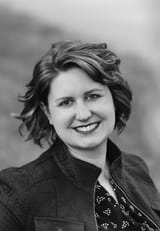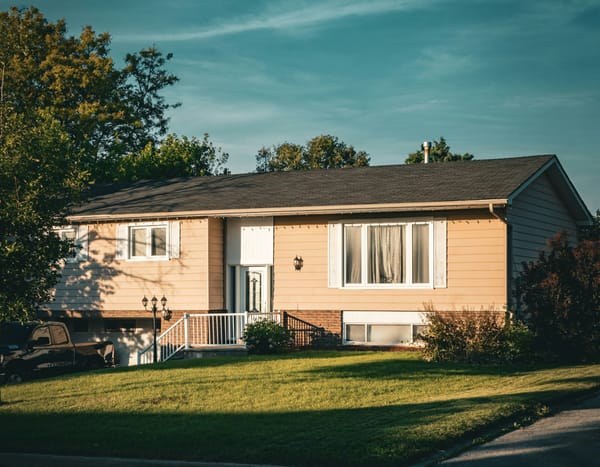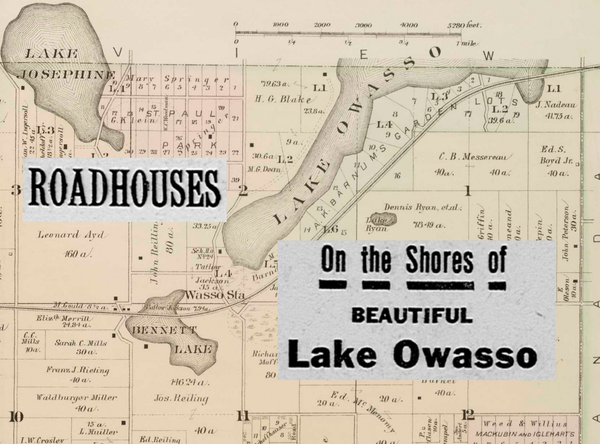"Dens of Infamy" on the storied shores of Lake Owasso
Uncovering the true history behind the campfire stories of South Owasso Blvd
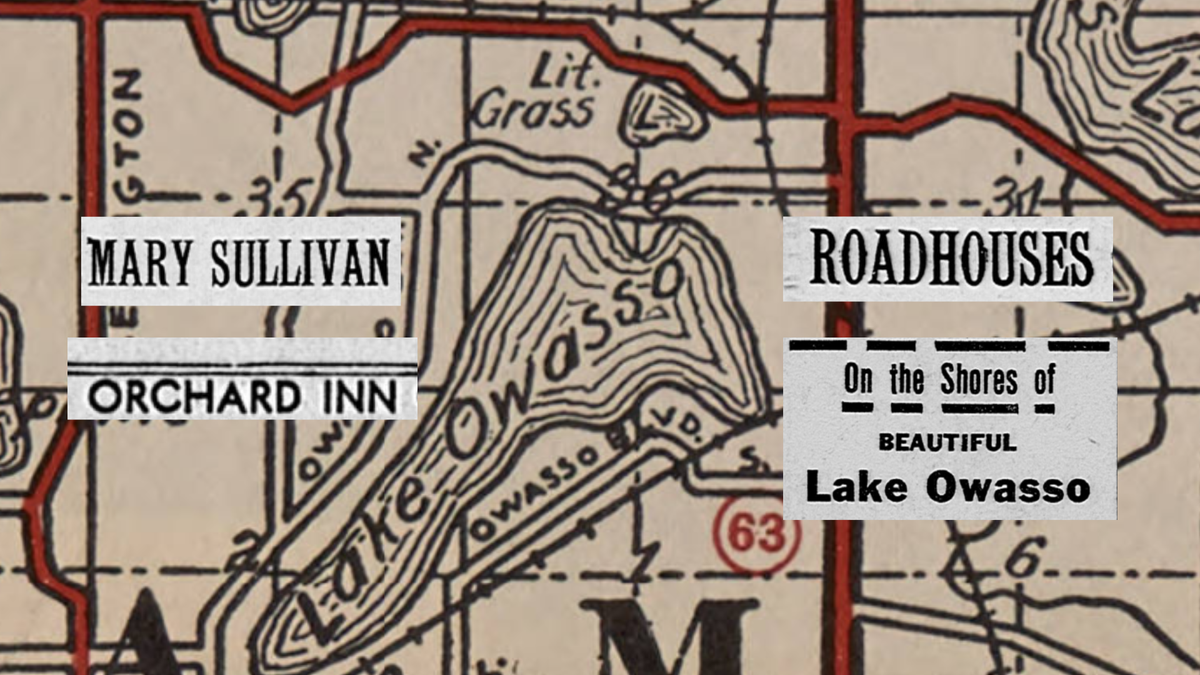
Gather round and listen closely, let us tell you what really happened in the early 20th century on the south shores of beautiful Lake Owasso.
It was here you could find “…the vicious debauchery that is going on daily and nightly at the dives in the vicinity of St. Paul, than which none are more notorious, and probably none more vicious, than those of Bass Lake or Lake Owasso.”
So went a 1910 editorial in the Saint Paul Daily News, calling for the closure of roadhouses in Saint Paul. Roadhouses were small cabins used as taverns or saloons and sometimes roadside motels for brief overnights or midday “nooners.” Roadhouses were frequently busted for selling liquor without a license and their operators charged with violations of liquor laws and for “keeping a disorderly house.” At the time, a disorderly house was defined as a place where alcohol was served illegally, men could consort with prostitutes, people regularly quarreled, or otherwise indecent behavior occurred in such a way that disturbed the neighborhood.
If you didn’t hear our first campfire story, now would be a good time to catch-up:

Two of these notorious roadhouses—sometimes called speakeasies—were along what is now South Owasso Boulevard, beginning in the early 1900s: The Orchard Inn and Mary Sullivan’s. Guests would travel to Lake Owasso via Rice Street or the train, which had a stop nearby.
The Kubitschek family lived in that area, settling in Rose Township on what is now 365 South Owasso Blvd around 1900. Their family farm was there for decades. According to the Roseville Historical Society’s account in Roseville Minnesota: The Story of Its Growth Volume Two published in 1998, their granddaughter Louise Kubitschek and her siblings would sometimes peek into the windows of The Orchard Inn and Mary Sullivan’s, “to see what the grownups were doing.” There were other farms and families in the neighborhood too, including the well-known Dr. Arthur Lundholm who owned all of Sandy Hook Drive. Louise later married Emil Cedarholm, who became mayor of Roseville starting in the early 1950s. Their home was located at the red pin on the map below.
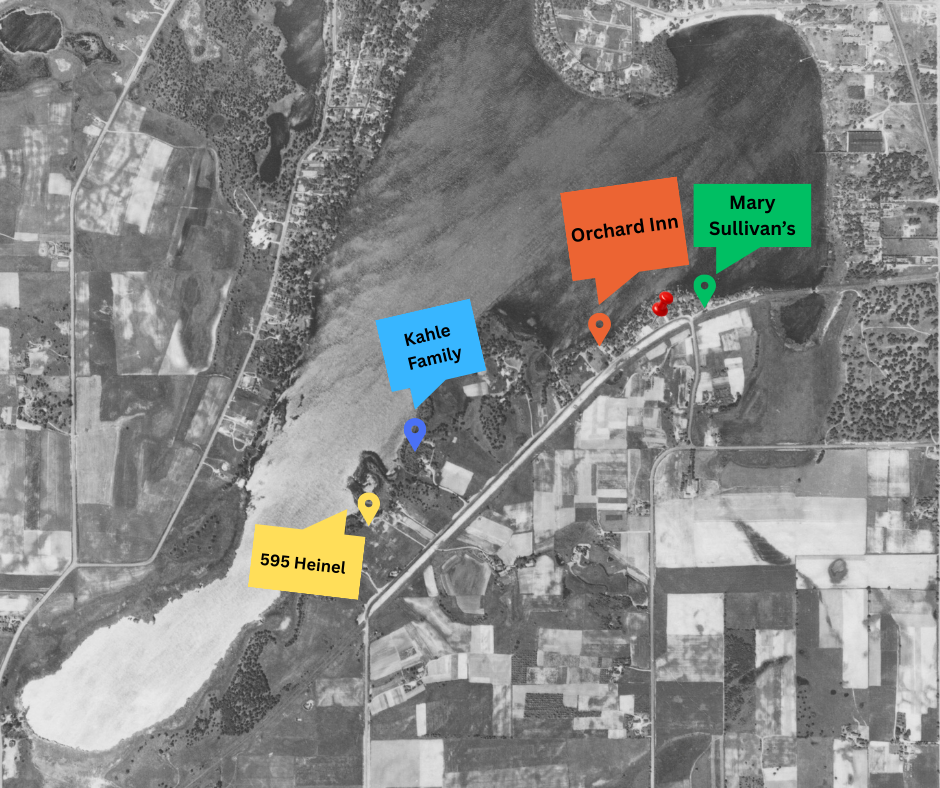
A Well-Known Woman of the Underworld
To the east of the Kubitschek farm, on the narrow dead-end strip of road along the railroad tracks, is the location of what is known as “Mary Sullivan’s.” This private drive now contains house numbers 349-313 South Owasso Blvd. In 1900 there were three houses here. On a land abstract for the neighborhood that dates back to the early 1900s, this road was referred to as the "Sullivan Club House Road."
Mary Sullivan, an unmarried woman, purchased this property (Lot 1 of A.K. Barnum’s Garden Lots) in 1907 for $2,000, which included all three houses on the strip. At her death, Sullivan was described as “a well-known woman of the underworld” by the Pioneer Press.

In his book John Dillinger Slept Here, John Macabee used the term “underworld” to describe the community of crooks, bank robbers, bootleggers, and gangsters of the 1920s and 1930s.
Sullivan’s property is where several people still living claim that infamous gangsters such as Baby Face Nelson, Al Capone, and members of the Barker-Karpis gang stayed in the 1920s or 1930s. But Lake Owasso, also known as Bass Lake, was an infamous haven for illicit activity well before gangsters skulked around Saint Paul. And as Macabee wrote in his book, criminals like these were first “initiated into crime and civic corruption through the bootleg liquor trade.”
Who was Mary Sullivan?
Before she bought property on Lake Owasso, Sullivan’s name appeared dozens of times in the newspaper in the late 1800s and early 1900s. Not all “Mary Sullivans” in the paper are the same woman, but based on context clues and the ages our Owasso Mary would have been, the following stories are quite likely to feature one and the same Mary Sullivan:
In 1880, Sullivan and a companion named Emma Degree were in police court, described as “two young girls who had been snatched from lives of impending sin, degradation and thrice cursed shame.” Sullivan was described as “a browsey looking strawberry blonde.” And at nineteen years old, had the “appearance of an old stager.”
Sullivan was arrested again in 1895 at age 35, alongside Lillie Griffin, from a saloon at Sixth and Wabasha Streets in Saint Paul.
In 1896, Mary Sullivan testified in a trial of Alderman Murphy—a Saint Paul city official charged with keeping a disorderly house at his wine room. The newspaper was quite vague about the details due to its lewd and scandalous nature, but it was clear from the testimonies that this saloon doubled as a brothel. “Much of the evidence was of such a character that it could not be put into type,” the reporter wrote.
Sullivan was there to testify as one of the women who was a regular at the wine room, though she tried to claim on the stand that she didn’t “mix up” with the other women there and only went there to eat meals.
The Pioneer Press reporter described her as “a rotund person with a self-possessed air, very deliberate of speech, and very careful of her replies.” In another article about the trial, she was described as “a thoroughly well-known character who has been about St. Paul for years, and is known to every policeman in the city.” She testified about her experience taking meals at Alderman Murphy’s Saloon and described the activities and people she’d seen there.
The next year, Sullivan was arrested again for “visiting a house of ill fame” on Jackson Street. The four men and three women were arrested and released on bail, “except Mary Sullivan who had no money or friends,” the Pioneer Press reported.
In 1901, Sullivan was arrested again for being in a “house of doubtful resort” and sentenced to ninety days in the workhouse.
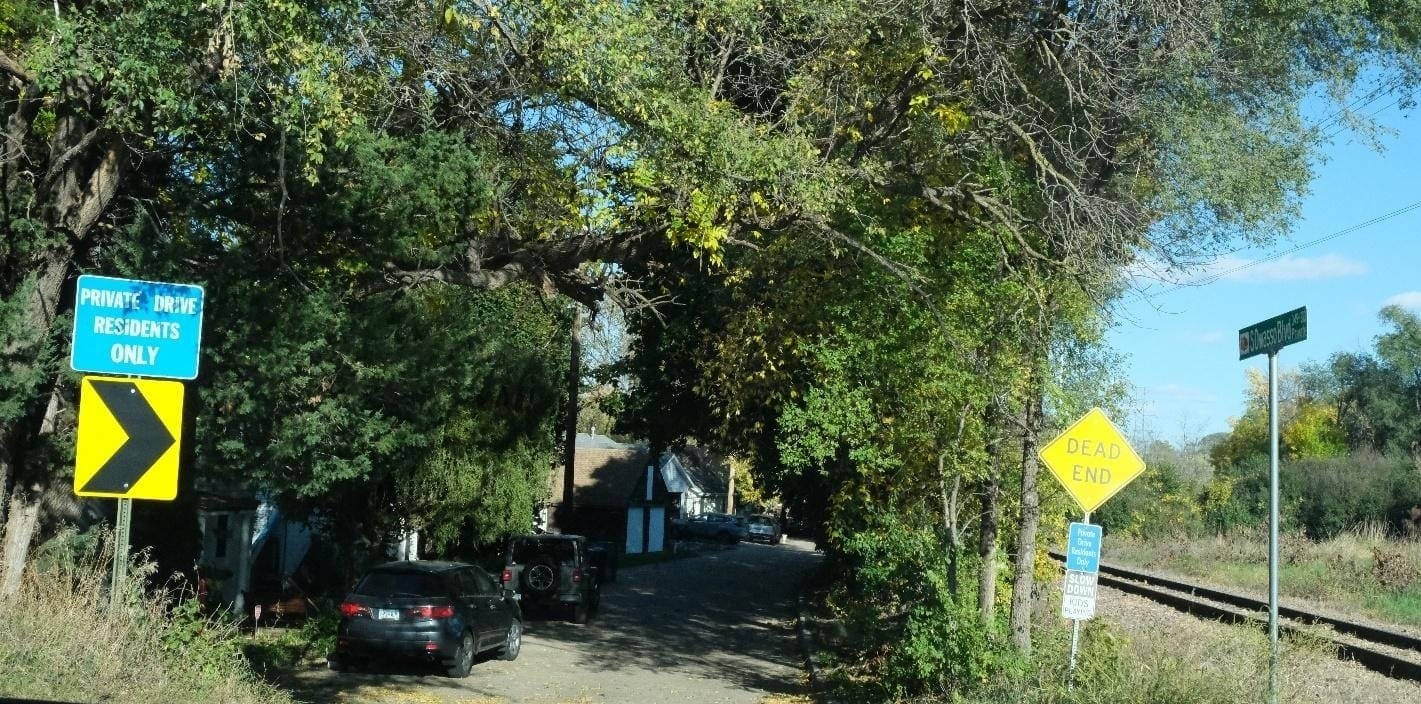
Six years later, Sullivan purchased her property on South Owasso Boulevard. Where did she get the money? Her $2,000 mortgage was financed by the Hamm Brewing Company. Interestingly, “Hamm Brewing became known for being an informal loan institution for the periphery of the underworld,” after the kidnapping and release of William Hamm in 1936, according to John Dillinger Slept Here. In Sullivan’s case, this started well before that.
Later she took out a mechanic’s lien and John McNulty served as her agent. McNulty was both a taxi driver and an owner of a few roadhouses and taverns in the Saint Paul area.
It was here that Ramsey County sheriff’s deputies raided the lake resorts in 1909 in what the Pioneer Press called “the first step toward breaking up the colony of notorious establishments at Bass Lake.”
Most of these roadhouses were very small cabins. While there were large night clubs on the north side of Lake Owasso—the Hawaiian Club and Breezy Point—the “resorts” or roadhouses on the southside were little cottages in the woods.

One time in 1909, a resort operator named Beech Fleury was stabbed in the abdomen with a razor after a fight with St. Paul Police Commissioner William Lucy, who had been visiting the roadhouse to meet a woman. Fleury was hospitalized, but survived. He operated his roadhouse alongside Martin McNulty. Records refer to it as the Berlin Club and the Woodland Club. Two places or the same? What we do know is that Martin McNulty was brothers with John McNulty, who got the mechanic’s lien on behalf of Mary Sullivan. And on the 1910 Census, Martin (also known as Mathis or Mat) was a neighbor of Mary Sullivan. So, either they operated neighboring roadhouses or they operated the roadhouse on the land Mary Sullivan owned.

A year after the stabbing, a man and woman were killed in an automobile accident on Rice Street after staying overnight at Fleury and McNulty’s roadhouse. The pair were later charged with keeping a disorderly house and the incident led to a campaign to bring an end to the roadhouses on Bass Lake.
“It is time the roadhouses in St. Paul were closed. This morning’s tragedy is a shocking exposure of the vicious debauchery that is going on daily and nightly at the dives in the vicinity of St. Paul, than which none are more notorious, and probably none more vicious, than those of Bass Lake or Lake Owasso, from one of which the waitress was hurrying to her day’s work after a night’s frolic. . . It is time the officers of the law were closing up these dens of infamy.” –1910 Editorial in the Saint Paul Daily News.
In 1911, Mary Sullivan was convicted for selling liquor without a license from her place on Bass Lake and fined $50.
She died in 1915 at the age of 52 and her death was announced in the Pioneer Press:
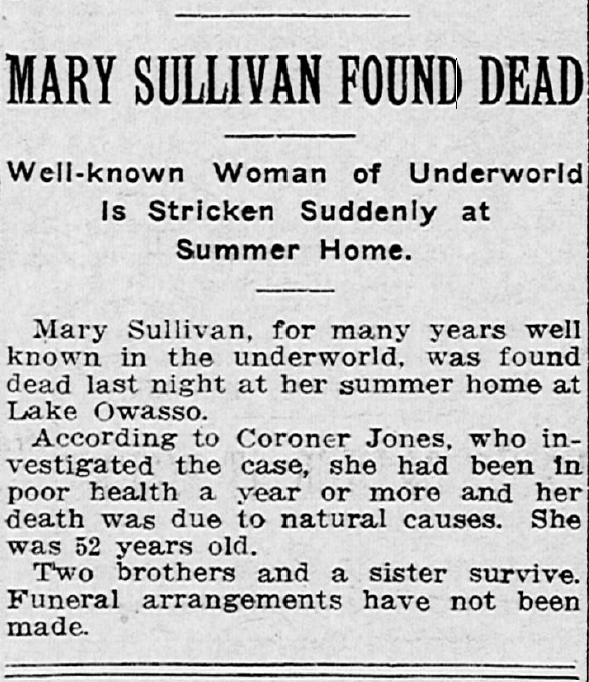
Gangsters at Sullivan's Place
Craig Fiebiger who grew up in Roseville near Lake Owasso in the 1960s remembers a house called Mary Sullivan’s near the railroad tracks on South Owasso Blvd. He doesn’t remember exactly where it was, but he remembers seeing it when visiting friends on that block.
His former father-in-law Bob Pace was cousins with a notorious bank robber from the 1930s known as Baby Face Nelson. The Roseville Reader confirmed via Ancestry.com that Baby Face Nelson, whose real name was Lester Gillis, was related to a Pace family.
“He would spend time there at Mary Sullivan’s and found refuge at another cousin’s house on Woodbridge to the north of the railroad tracks off Rice in Shoreview,” Fiebiger told the Roseville Reader. He said Baby Face Nelson also frequented a bar where the Burger King is currently. That would have been the Owasso Garden Club, later the Torch.
Mary Sullivan died in 1915, so she wouldn’t have hosted Baby Face Nelson or any of these other gangsters herself. But it seems her name lived on. Before she died she sold her property to Michael and Ida Sullivan who kept it until 1931. After that, it was sold for $1 and divvied up into subdivisions.
The Orchard Inn
Where Mary Sullivan’s story ends, the next one begins. The other prominent resort operator on the south side of Lake Owasso was Fred Herbst. Herbst and his wife Irene owned the Orchard Inn which had a restaurant and cabins for rent for several decades located on the 400 block of South Owasso Boulevard. He owned 6 parts of Lot 2 of A.K. Barnum’s Garden Lots. Herbst was a gray-eyed, brown-haired man who stood five foot, three inches tall at 151 pounds when he registered for the draft in 1942.
Ads for the Orchard Inn appear in the Pioneer Press starting in 1938. However, Herbst shows up in the news before the Orchard Inn does (and before he was married), arrested for selling illegal liquor at a place on Bass Lake. The first time was in 1919 when Herbst was arrested along with Lottie Schuette and charged with creating and maintaining a nuisance.

This was right at the beginning of Prohibition, just a couple of months before the Volstead Act was signed into law. Already, illegal sales of alcohol were a booming business. The Pioneer Press painted a dramatic picture in that August 13, 1919 article:
“The 'thirst' portrayed in desert scenes in the movies apparently had nothing on that of St. Paul and Minneapolis residents who patronized these road houses, where sky-high prices are said to have been asked for drinks containing a 'kick.' Ordinary beer, which the patron purchased in the days of the open saloon at 15 cents a pint, was snapped up ravenously at these road houses at 75 cents and $1 a pint, according to the authorities.”
For perspective, in today’s dollars that pint would have cost 15-20 bucks.
The reporter concludes that one must have a “fat pocketbook” to afford to drink at places such as this.
A couple months later, Herbst’s case was dismissed after he testified that the men at his place were workers on his “farm” and that the bottles in the ice box were actually “ginger ale.”
Ten years later in 1929, Herbst was swept up in another raid by Federal Prohibition agents and charged with “sale and nuisance.”
In 1932, the main building of his resort burned to the ground after a bucket brigade failed against a gust of wind which fanned the blaze.
The Orchard Inn rose from the ashes and no further arrests were reported in the Pioneer Press after that—just ads promoting the cabins for rent and occasionally want ads for open positions for hire.

The next time Herbst appeared in the paper was 1960, when he testified in the “Cann Trial” regarding a defendant who was charged with transporting a 27-year-old woman over state lines on four occasions “for immoral purposes and debauchery.” Herbst testified that Cann rented a cabin and had been there several times for dinner with guests.
Remembering Freddie
There are still people today who remember Herbst, who they refer to as “Freddie.”
Glenn Kloskin, President of Boater’s Outlet, worked for the proprietor of The Orchard Inn in the 1960s and said Herbst called him any time of day or night to plow the driveway for guests.
Jim and Betty Duddleston, who used to live on the former Orchard Inn property, remember him too. They lived next door until they purchased 4 of the 6 lots Herbst owned in 1969.
In the late 1960s the Orchard Inn was still in operation, though the restaurant had been closed for years. The Duddlestons regularly saw “old man Herbst” bringing clean sheets to the little cabins on his property in the morning and returning with dirty sheets in the afternoon. Often one businessman or another and his “lady friend” would arrive for lunch and then leave by 3:00 p.m.
According to the Duddlestons, Herbst wanted to donate his land and the Orchard Inn to the Catholic Church in 1969, but they convinced him to sell them the property instead and donate the money. They renovated the original Orchard Inn into their family home, keeping the original fireplace and dining room. They lived there until 1977.
The late Bob Bell, a former state representative for the Roseville area and Roseville City Attorney for 36 years, moved to Lake Owasso when his parents rented a home from Emil Cedarholm in 1955. He later purchased land and built a house on 737 Heinel Drive. In 1998 he was interviewed for an oral history project called Remembering Roseville with the Minnesota Historical Society. He described Herbst as very quiet with no close neighbors. In the interview, Bell recalled this about Herbst:
“He rented out rooms on Lake Owasso for what people thought were very suspicious reasons, but he was quiet and nothing ever happened, but I’m told that old timers could go in there, and for $1 you could get whatever you wanted. He never had a liquor license but you could get a martini, whatever you want."
Herbst died in 1980 at the age of 96.
What of the Speakeasies on Heinel Drive?
The houses that started this investigation into speakeasy history were 525 Heinel—Peggy Kennedy’s house with a sealed off tunnel between the old house foundation and the garage—and 595 Heinel—the 1934 house with a trap door, antique liquor bottles found in the lake, and a wooden butler in the attic.
What we found was much less salacious than the history of Mary Sullivan's story or the Orchard Inn. 525 Heinel was a resort for a long time, owned by Anna Kahle and her family. Anna and her husband Frederick Martin bought the land in 1895. The family lived there and also formed a family business—a resort with boat rental, and fishing and hunting grounds. There is one sad story about fishermen who drowned after their boat capsized, but no reports of arrests related to breaking any liquor laws or for running a disorderly house. When Frederick Martin Kahle Sr. died in 1918 he was described as a “friend of sportsmen.”
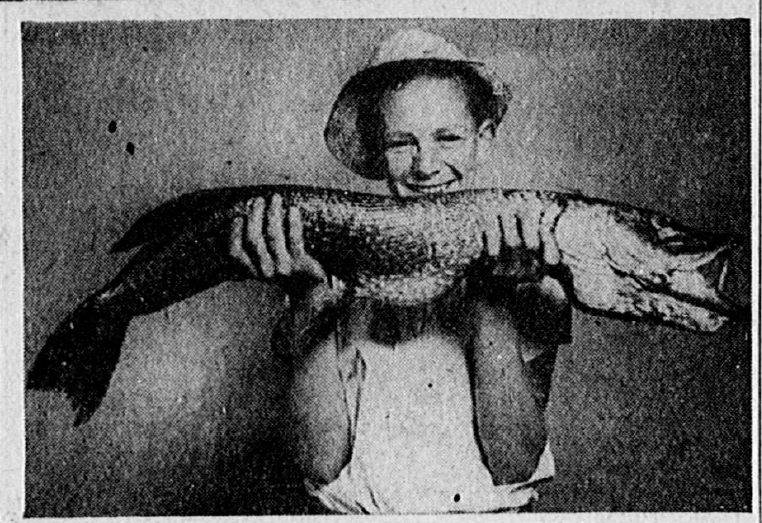
Anna kept the resort going until WWII. Anna and her other son Fred sold the land and moved to Hague Ave in 1941. Sadly, her grandson Martin died in the South Pacific in 1944 and her son William died in Saint Paul the following year. In 1952 when Anna Kahle died at the age of 79, the Pioneer Press ran an article with a big headline and a smiling photo of her.
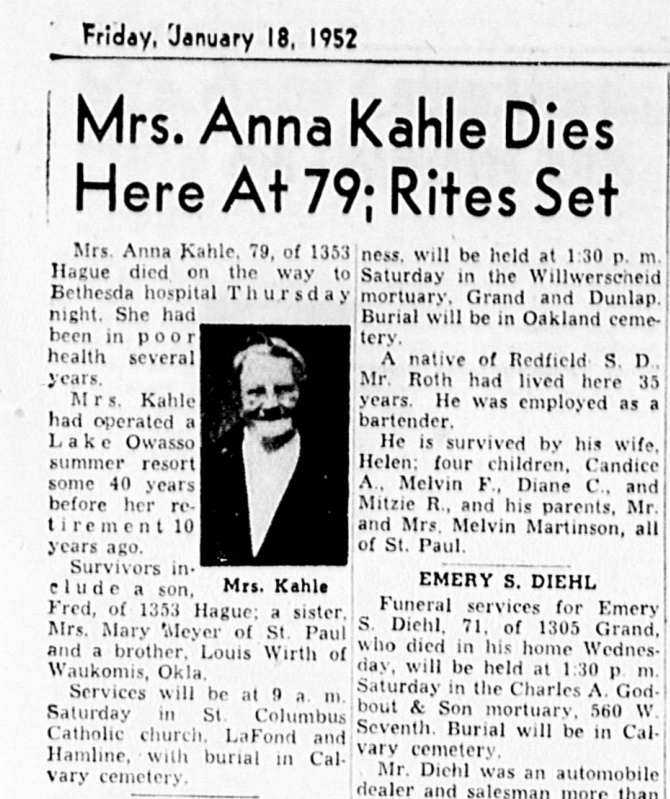
As for the “speakeasy” at 595 Heinel Drive, that land was occupied at least as early as 1910. It was part of Lot 11 of A.K. Barnum's Garden Lots, next to the Kahle family. None of the property owners' names appear in the Pioneer Press for reasons related to crime or court.
We couldn’t find any evidence in the historical record of any roadhouse or gangster activity on what is now Heinel Drive. But that doesn’t mean there never was. Perhaps they just never got caught.
Editorial Note: The information in this article was researched and reported by Peggy Kennedy and Naomi Krueger through a series of conversations with neighbors around the lake and a deep dive into census records, property records, land abstracts, the Minnesota Historical Society newspaper archives, maps, and other publicly available materials. Special thanks to the Minnesota Historical Society for making so much of this information accessible. Unless otherwise noted, all newspaper quotes are from the Saint Paul Pioneer Press.
It is difficult to prove that all of the Mary Sullivan stories in the Pioneer Press before she lived at Lake Owasso were all the same person. If you’re a historian or a community member who knows different details about Mary Sullivan and you want to correct the record, reach out to news@rosevillereader.com.
Peggy Kennedy has lived on Lake Owasso with Mike Feist since 2005. Her career was with the University of Minnesota as a County 4-H/Home Economist and a district manager of Targeted Services & Cultural Services with Roseville Area Schools. Since retiring in 2013, she's had a wedding dress alterations business and spends lots of time with her four grandkids. Peg grew up in Pequot Lakes next to the infamous gangster-owned Breezy Point resort.
Naomi Krueger is the editor of the Roseville Reader. She lives in Roseville with her husband, two sons, and their cocker spaniel Yeti. When she’s not reporting on Roseville, you can find her editing children’s books, watching her kids play basketball, and enjoying all the community has to offer.

